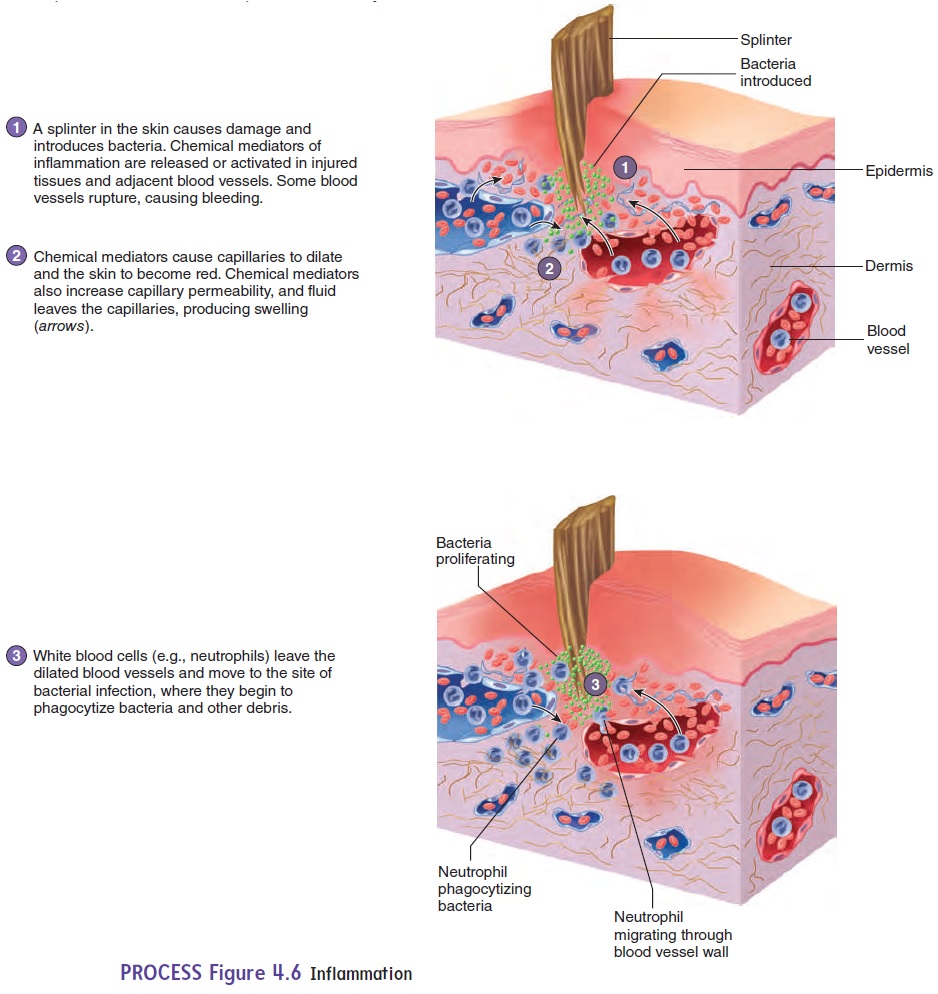Chapter: Essentials of Anatomy and Physiology: Tissues
Tissue damage and inflammation
Tissue damage and inflammation
Describe the process of inflammation in response to tissuedamage, and explain how inflammation protects the body.

PROCESS Figure 4.6 Inflammation
Inflammation (flamma,flame) occurs when tissues are damaged.For example, when viruses infect epithelial cells of the upper respi-ratory tract, inflammation and the symptoms of the common cold are produced. Inflammation can also result from the immediate and painful events that follow trauma, such as closing your finger in a car door or cutting yourself with a knife. Figure 4.6 illustrates the stages of the inflammatory response. Inflammation mobilizes the body’s defenses and isolates and destroys microorganisms, foreign materials, and damaged cells so that tissue repair can proceed . Inflammation produces five major symptoms: redness, heat, swelling, pain, and disturbance of func-tion. Although unpleasant, the processes producing the symptoms are usually beneficial.
Following an injury, substances called chemical mediators are released or activated in the injured tissues and adjacent blood vessels. The mediators include histamine (his′\tă-mēn) and prostaglandins (pros-tă-glan′\dinz). Some mediators cause dilationof blood vessels, which produces redness and heat, similar to what occurs when a person blushes. Dilation of blood vessels is beneficial because it increases the speed with which blood cells and other substances important for fighting infections and repairing the injury are brought to the injury site.
Chemical mediators of inflammation also increase the per-meability of blood vessels, allowing materials and blood cells to move out of the vessels and into the tissue, where they can deal directly with the injury.Edema (e-dē′\mă), or swelling, of the tis-sues results when water, proteins, and other substances from the blood move into the tissues. One of the proteins, fibrin, forms a fibrous network that “walls off” the site of injury from the rest of the body. This mechanism can help prevent the spread of infec-tious agents. One type of blood cell that enters the tissues is the neutrophil (noo′\trō-fil), a phagocytic white blood cell that fightsinfections by ingesting bacteria. Neutrophils die after ingesting a small number of bacteria; the mixture of dead neutrophils, other cells, and fluid that can accumulate is called pus.
Pain associated with inflammation is produced in several ways. Nerve cell endings are stimulated by direct damage and by some chemical mediators to produce pain sensations. In addition, the increased pressure in the tissue caused by edema and pus accu-mulation can cause pain.
Pain, limitation of movement resulting from edema, and tissue destruction all contribute to the disturbance of function, which can be adaptive because it warns the person to protect the injured area from further damage.
Chronic Inflammation
Chronic, or prolonged, inflammation results when the agent respon-sible for an injury is not removed or something else interferes with the healing process. Infections of the lungs or kidneys usually result in a brief period of inflammation followed by repair. However, prolonged infections, or prolonged exposure to irritants, can result in chronic inflammation. Chronic inflammation caused by irritants, such as silica in the lungs, or abnormal immune responses can result in the replacement of normal tissue by fibrous connective tissue. Chronic inflammation of the stomach or small intestine may cause ulcers. The loss of normal tissue leads to the loss of normal organ function. Consequently, chronic inflammation of organs, such as the lungs, liver, or kidneys, can lead to death.
When the inflammatory response lasts longer or is more intense than is desirable, drugs are sometimes used to suppress the symp-toms by inhibiting the synthesis, release, or actions of the chemi-cal mediators of inflammation. For example, medications called antihistamines suppress the effects of histamine released in people with hay fever. Aspirin and related drugs, such as ibuprofen and naproxen, are effective anti-inflammatory agents that relieve pain by preventing the synthesis of prostaglandins and related substances.
Related Topics